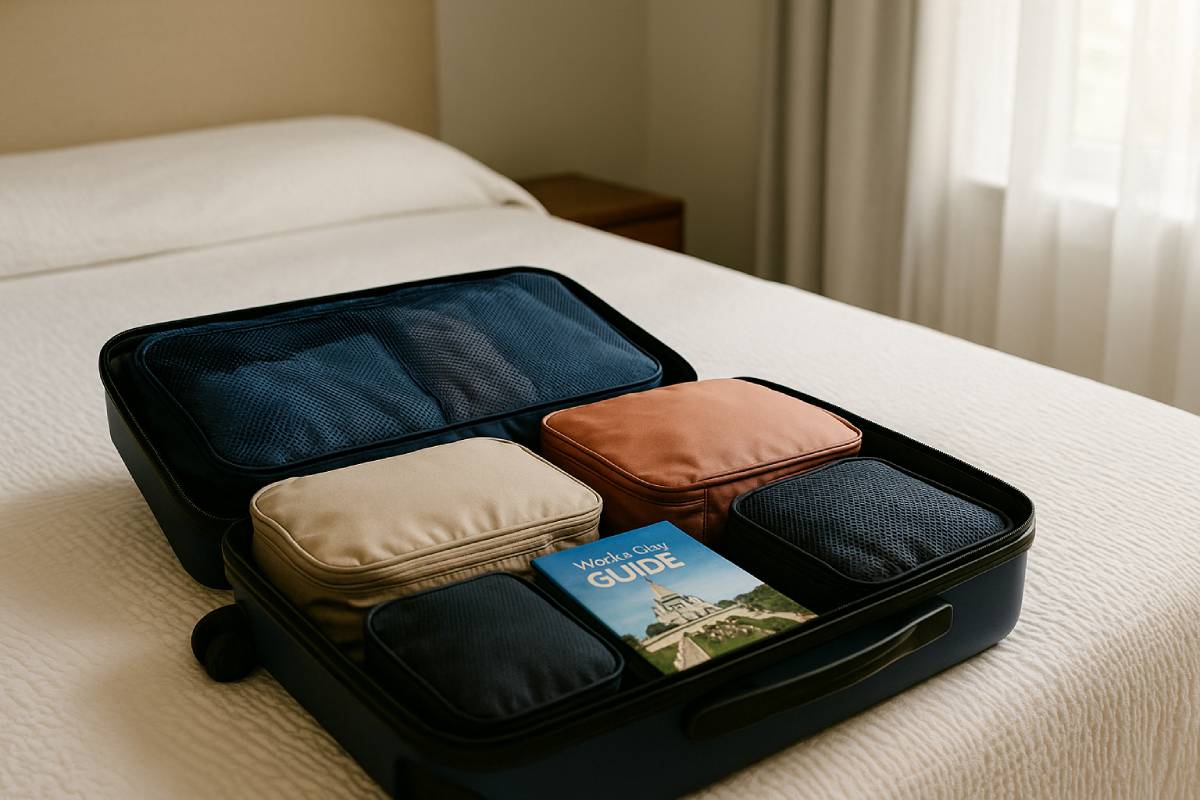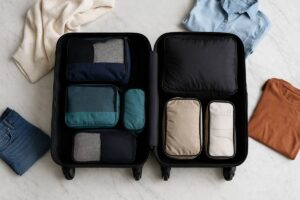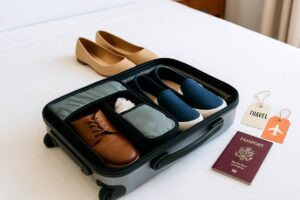Packing cubes aren’t just trendy pouches—they’re the secret to stress-free travel, turning suitcase chaos into a well-orchestrated system that saves time at every destination.
By matching cube count and size to your trip length, you’ll slash wasted space, keep outfits sorted, and breeze through airport security like a pro.
Whether you’re headed out for a quick city break or globetrotting for a month, this guide shows you exactly how many cubes you need, which sizes work best, and the expert packing techniques that will change the way you travel forever.
Why Packing Cubes Matter
Packing cubes aren’t just pretty pouches—they transform overstuffed bags into streamlined, stress-free luggage systems, letting you see exactly where every shirt, sock, and accessory lives.

At the same time, modern compression-style cubes can slash your bulk by 20–30%, reclaiming precious space for souvenirs or that extra pair of shoes.
Packing cubes are the secret weapon of seasoned travelers: they keep outfits sorted and suitcase “Tetris” to a minimum, while also squeezing down bulky layers so you can pack more without paying extra baggage fees.
Benefits Overview
| Aspect | Benefit |
|---|---|
| Space optimization | Compression cubes can reduce bulk by 20–30%, with average savings around 20% of bag volume |
| Categorization | Grouping like items into dedicated cubes (e.g., tops, bottoms, undergarments) speeds outfit selection and simplifies laundry routines |
| Wrinkle reduction | Properly packed cubes eliminate shifting, minimizing creases and wrinkles in your clothes |
Compression Savings at a Glance
| Compression Benefit | Space Saved |
|---|---|
| Average | ~20% |
| Maximum | Up to 30% |
Common Missteps to Avoid
- Overstuffing cubes: Squeezing too much in makes zippers strain, fabric tear, and can actually introduce wrinkles rather than prevent them.
- Excessive cubes: Filling your bag with unlabeled or redundant cubes can create clutter instead of clarity—stick to a handful of well-marked pouches for maximum efficiency.
How Trip Length Influences Cube Strategy
Longer journeys demand more cubes—and a solid laundry strategy—while short trips thrive on minimal, well-chosen sets that cover clean, dirty, and specialty items. Whether you’re grabbing a carry-on for a long weekend or packing a 100 L backpack for a month abroad, matching cube count to trip length—and reserving one for laundry—keeps you organized, minimizes wrinkles, and frees up space for extras.
For quick 5–7 day jaunts, most travelers get by with 3–6 cubes (many even start with three, rotating one as a laundry bag). On extended trips, follow the rule of thumb of one cube per 10 L of capacity—so a 60–120 L bag calls for 6–12 cubes—and plan laundry every 7–10 days, using dedicated clean and soiled cubes to stay fresh.
Packing cubes streamline both space and workflow: longer trips require more “slots” for clothing and gear, plus a rotation plan to separate clean from dirty; shorter trips benefit from fewer, multi-purpose cubes that still keep outfits organized without excess bulk.
The Week-Long Trip Mindset
For a 5–7 day adventure, aim for 3–6 packing cubes—enough to sort by category without overwhelming your case.
- Laundry rotation: Reserve one cube as a “laundry” bag: as you wear items, move them into this cube, then swap it out when it’s time to wash—often around day 5–7.
- Size mix: A balanced set includes one large cube for bulk items (sweaters, pants), two medium cubes for daily outfits, and one small cube for undergarments and toiletries.
The Month-Long Journey Approach
When you’re on the road for 4 weeks or more, scale up thoughtfully:
- Rule of thumb: Pack one standard compression cube per 10 L of bag capacity—so a 60 L pack needs about six cubes; a 120 L bag, about twelve.
- Estimated count: Plan for 6–12 cubes total, mixing compression and regular cubes based on your bulk and space needs.
- Laundry planning: Do laundry every 7–10 days, using designated “clean” and “dirty” cubes to keep garments separate and fresh.
- Destination variation: Allocate extra cubes for climate-specific layers (e.g., down jackets, swimwear) or specialty gear (tech accessories, hiking socks) to keep them compartmentalized and accessible.
Quick Comparison Table
| Trip Length | Cube Count | Laundry Plan | Size Mix & Extras |
|---|---|---|---|
| 5–7 days | 3–6 cubes (often 3) | 1 cube reserved for laundry rotation | 1 large, 2 medium, 1 small |
| 30+ days | 6–12 cubes | Laundry every 7–10 days, clean vs. dirty | Mix all sizes + extra cubes for layers & specialty gear |
By tailoring cube count and composition to your trip length—and embedding a simple laundry-swap routine—you’ll stay organized, minimize wrinkles, and maximize space, whether you’re off for a quick city break or globetrotting for a month.
Choosing the Right Cube Sizes
Choosing the right packing cube size turns chaotic luggage into a well-orchestrated system: large cubes (~30 L) tame bulky sweaters and jackets, medium cubes (15–20 L) neatly hold one to two tops plus a bottom for daily outfits, and small cubes (5–10 L) keep undergarments and toiletries contained—maximizing space, simplifying outfit selection, and preventing spills
By matching cube volume to your contents, you’ll streamline packing, protect delicate fabrics, and use every inch of your bag efficiently.
Large Cubes (30–35 L)
Large cubes typically range from 30–35 liters, designed to accommodate bulkier items without overstuffing your bag.
Major brands like Zoomlite include these generously sized cubes in their 10-piece sets, perfect for stashing heavy layers such as sweaters, jackets, or a weekend coat.
Medium Cubes (15–20 L)
Medium cubes generally hold 15–20 liters, making them ideal for packing 1–2 tops plus a bottom per cube, streamlining daily outfit planning.
Their form-fitting shapes slide easily into carry-on compartments, providing quick access to essentials without unpacking everything.
Small Cubes (5–10 L)
Small cubes range from 5–10 liters, perfect for undergarments, socks, scarves, and other accessories that tend to get lost in larger spaces.
Opting for a water-resistant small cube doubles as a toiletry pouch, safeguarding your liquids and cosmetics from accidental spills.
Quick Size-Use Reference
| Cube Category | Approx. Capacity | Ideal Contents |
|---|---|---|
| Large | 30–35 L | Bulk layers (sweaters, jackets, coats) |
| Medium | 15–20 L | 1–2 tops + 1 bottom (daily outfits) |
| Small | 5–10 L | Underwear, socks, accessories, toiletries |
By matching cube size to content, you’ll streamline packing, protect delicate fabrics, and maximize every inch of luggage space.
Packing Techniques & Organization Tips
Mastering these packing cube techniques—from choosing when to fold or roll, to color-coding and strategic placement—will transform your suitcase into a streamlined, stress-free system.
OTTE Gear’s expert guidelines show that rolling works best for soft knits like T-shirts and base layers, while Carl Friedrik’s luxe cubes are built to preserve structured pieces, making folding the preferred method for jackets and dresses.
Meanwhile, travel pros recommend color-coding cubes or adding simple zipper tags for instant identification, plus a master “contents index” for multi-stop trips. Finally, load the heaviest cubes at the bottom for stability and keep your go-to essentials—think toiletries or travel documents—on top for easy access.
Folding vs. Rolling
Choosing the right method depends on the fabric and garment structure. Rolling is ideal for soft knits and T-shirts—it squeezes out air, contours around curves, and helps prevent wrinkles. Folding, by contrast, is better for structured garments—like blazers, dresses, and button-ups—since it preserves seams and avoids harsh creases.
Quick Technique Comparison
| Technique | Best For | Key Benefit |
|---|---|---|
| Rolling | Soft knits & T-shirts | Minimizes wrinkles, maximizes volume |
| Folding | Structured garments (jackets, dresses) | Preserves shape, avoids creasing |
Labeling & Color Coding
Efficient labeling turns packing cubes into an intuitive system. Family-travel pros swear by using different colored cubes for each person or item category—assign blue for tops, red for bottoms, green for undergarments—and instantly know what’s where.
For a budget-friendly tag solution, heat-shrink tubing slips over zipper pulls in a rainbow of hues and won’t snag or fade. When tackling multi-destination trips, draft a master “contents index”—a one-page map listing each color or tag and its contents—so you never have to unzip every cube to find what you need.
Labeling Methods at a Glance
| Method | Description | Best For |
|---|---|---|
| Colored Cubes | Assign distinct cube colors per person or item category | Family/group travel |
| Zipper Tags | Use heat-shrink tubing or plastic tags on zipper pulls | Solo travelers, budget setups |
| Contents Index | One-page guide mapping cube colors to contents | Multi-stop itineraries |
Strategic Placement
How you layer cubes inside your bag impacts both stability and convenience. Pack your heaviest cubes—filled with bulk items like sweaters or shoes—at the bottom, near the wheels or hinges, to lower your bag’s center of gravity and prevent tipping when rolling. Then reserve the top layer for your in-transit essentials—think a toiletry cube or document pouch—so you can grab them without unpacking everything.
By applying these expert-backed methods—matching fold vs. roll to fabric, color-coding every cube, and layering strategically—you’ll pack smarter, find more in less time, and arrive feeling organized.
Sample Packing Scenarios
Packing for real trips means more than tossing clothes in a bag—it’s about creating a system that keeps you organized from arrival to departure.

For a 7-day city break, most travelers pack 5–6 cubes—including a dedicated laundry pouch—to cover bulk layers, daily outfits, and undergarments, with medium cubes rotated through a simple outfit schedule.
On a 30-day backpacking tour, you’ll scale up to about 8–10 cubes, plan to do laundry every seven days, and carve out 20–25% of your cube space for gear (electronics, chargers, first-aid) versus 75–80% for apparel—keeping clean and dirty items separate to stay fresh on the road.
7-Day City Break
For a week in the city—think museums by day, tapas by night—you need just enough cubes to cover each outfit, plus one for dirty laundry and one for bulk layers.
| Cube Role | Cube Size | Quantity | Source |
|---|---|---|---|
| Bulk layers (coat, sweater) | Large (30–35 L) | 1 | Zoomlite recommends 4–6 cubes per trip |
| Daily outfits | Medium (15–20 L) | 3 | Travel + Leisure suggests 5–6 cubes for 5+ days |
| Undergarments & socks | Small (5–10 L) | 1 | Livingetc notes a small cube for laundry or small items |
| Laundry rotation | Medium or Small | 1 | Pro tip: reserve one cube for dirty clothes |
Outfit Planning Grid
Rotate medium cubes through your week so you never wear the same outfit twice back to back—washing one cube’s worth while you travel light.
| Day | Cube #1 | Cube #2 | Cube #3 |
|---|---|---|---|
| 1 | Top A + Bottom A | ||
| 2 | Top B + Bottom B | ||
| 3 | Top C + Bottom C | ||
| 4 | Top A + Bottom A | ||
| 5 | Top B + Bottom B | ||
| 6 | Top C + Bottom C | ||
| 7 | Top A + Bottom A |
Build outfits around versatile pieces—plan 8 tops and 3–4 bottoms for mix-and-match ease.
30-Day Backpacking Tour
Long-haul trips demand more cubes and a robust laundry rhythm to keep you fresh across weeks of exploration.
| Task | Recommendation | Source |
|---|---|---|
| Total cubes | 8–10 (proportional to 4–6 for a week) | Zoomlite’s 4–6-cube baseline for trip planning |
| Laundry schedule | Every 7 days (limit clothing to 7 days’ worth) | REI’s “no more than seven days’ worth” rule |
| Gear vs. apparel split | ~2 cubes for gear/tech, 6–8 cubes for clothing | Wandering Bajan’s electronics pouch strategy |
| Cube mix | 2 large, 4 medium, 2 small | Just Gone Wandering recommends size mix |
Laundry cycle example:
- Days 1–7: Wear cubes #1–3, wash at the end of day 7
- Days 8–14: Wear cubes #4–6, wash at the end of day 14
- Days 15–21: Wear cubes #7–8 + one clean medium cube, wash at the end of day 21
- Days 22–30: Rotate through fresh cubes, final wash before return
By tailoring cube counts and schedules to your trip length—and carving out space for both gear and garments—you’ll unpack smoothly, avoid laundry panics, and stay organized whether you’re exploring Barcelona for a week or trekking through Southeast Asia for a month.
Tools, Resources & Calculator
Embark on smarter packing with these essential tools and resources: an embedded Packing Cube Calculator widget for instant cube-count recommendations, a downloadable Printable Packing Cube Checklist to keep you on track, and a detailed comparison table of top cube brands and models so you can choose the perfect set for your journey.
Packing Cube Calculator Widget (Embed)
Embedding an interactive Packing Cube Calculator widget lets travelers input their luggage volume (in liters) and instantly receive a recommended cube count based on the “1 cube per 10 L” rule—eliminating guesswork and ensuring you pack just the right amount.
Example implementation (paste into your site’s HTML):
Downloadable Printable Checklist
A well-designed printable packing cube checklist breaks down items by cube size, clothing category, and laundry rotation—so nothing gets left behind when you head out the door.
- Study Abroad Packing Checklist (PDF): Includes packing cubes, laundry bag, and tech compartments—ideal for intensive trips
- NeatHouseSweetHome Printable List: A minimalist packing essentials sheet adaptable to any destination
- Free Printable Packing List by JustAGirlAndHerBlog: Offers both filled-in and blank versions so you can tailor to your packing cube strategy
Top Cube Brands & Models Comparison Table
Below is a comparison of top packing cube brands and models—covering materials, size ranges, compression features, and price points—so you can select the set that best matches your travel style and budget.
| Brand & Model | Material | Size Range (L) | Compression Feature | Price Range (USD) | Best For |
|---|---|---|---|---|---|
| Eagle Creek Pack-It Reveal | Ripstop nylon | 2-35 | No | 20 – 50 | Durability & water resistance |
| Shacke 5-Piece Set | Polyester mesh | 3-20 | Light | 15 – 30 | Budget-friendly basic organization |
| Thule Subterra Compression Cube | Nylon blend | 10-35 | Yes | 30 – 70 | Maximize space in carry-ons |
| Patagonia Black Hole Cubes | Recycled nylon | 3-20 | Light | 25 – 50 | Eco-friendly & tear-resistant |
| Amazon Basics 4-Piece Set | Polyester | 2-20 | No | 12 – 20 | Affordable starter option |
| Nomatic Compression Packing Cube | Polyester blend | 15-30 | Yes | 40 – 60 | High compression for overpackers |
| Calpak Packing Cubes | Nylon | 5-35 | No | 25 – 55 | Stylish patterns & sturdy zippers |
| Béis Signature Cubes | Water-resistant nylon | 5-25 | No | 35 – 60 | Sleek design & accessory pockets |
Table data compiled from Always Wander, Pack Hacker, Consumer Reports, Travel + Leisure, and The Cut.
Conclusion
By calibrating your packing cube count to the duration of your trip—from a concise 3–6 cubes for a week-long escape to a robust 6–12 cubes for month-long adventures—you’ll maximize every inch of luggage space and simplify outfit planning.
The “one cube per 10 L” rule provides a reliable baseline for longer journeys, ensuring you pack enough containers without overburdening your bag. For shorter stays, reserving one cube as a dedicated laundry pouch keeps clean clothes separate and your system organized. Choosing the right cube sizes—large (30–35 L) for bulk layers, medium (15–20 L) for daily outfits, and small (5–10 L) for undergarments and toiletries—ensures each item has its ideal compartment.
Employing expert techniques like rolling knits and folding structured pieces prevents wrinkles and optimizes space. Adding color-coded labels or zipper tags, along with a master contents index, makes locating items instant. Strategically placing heavier cubes at the bottom and essentials at the top stabilizes your luggage and prioritizes access.
Tools such as the packing cube calculator widget and a printable checklist streamline planning and execution for any trip length. Put these strategies into practice, and you’ll transform packing from a chore into a seamless part of your travel experience.
FAQs
What is the ideal number of packing cubes for a week-long trip?
Most travelers use 3–6 cubes, reserving one as a laundry bag around day 5–7 to keep clean and dirty clothes separate.
How do I decide between compression and standard cubes?
Choose compression cubes when you need extra space savings (up to 20 % bulk reduction) and standard cubes when you prioritize quick access and visibility.
Can I fit more items with packing cubes?
Yes—properly organized cubes prevent clothes from shifting, letting you pack denser and fit more items compared to loose packing.
How often should I do laundry on a month-long trip?
Plan to wash every 7–10 days, using dedicated “clean” and “dirty” cubes to rotate your wardrobe efficiently without laundry panics.
Are packing cubes allowed by TSA?
Absolutely—TSA encourages organized luggage and cubes help agents scan and repack bags with ease.





















